FORD ESCORT 1997 7.G Owners Manual
Manufacturer: FORD, Model Year: 1997, Model line: ESCORT, Model: FORD ESCORT 1997 7.GPages: 191, PDF Size: 2.02 MB
Page 131 of 191

To check the engine oil, follow
these steps:
1. Once the engine is warm, turn
the engine off. Make sure the
vehicle is parked on level ground.
2. Automatic transaxle:
²Engage the parking brake.
²Place the gearshift in P.
Manual transaxle:
²Engage the parking brake.
²Depress the clutch and place
the gearshift in first gear.
3. Open the hood. If you need
assistance, refer toOpening the
Hoodin this chapter. Protect
yourself from engine heat.
4. Remove the engine oil dipstick
and wipe it clean. Insert the
dipstick fully, then remove it again.
The oil level should be in the
range shown on the dipstick.
5. Carefully pull the dipstick out
again. If the oil level is below the
ADD arrow, add engine oil as
necessary. If the engine oil is
beyond the FULL arrow, engine
damage or high oil consumption
may occur and some oil must be
removed from the engine.
6. Put the dipstick back and
ensure that it is properly seated.
ADD FULL
Maintenance and care
131
Page 132 of 191
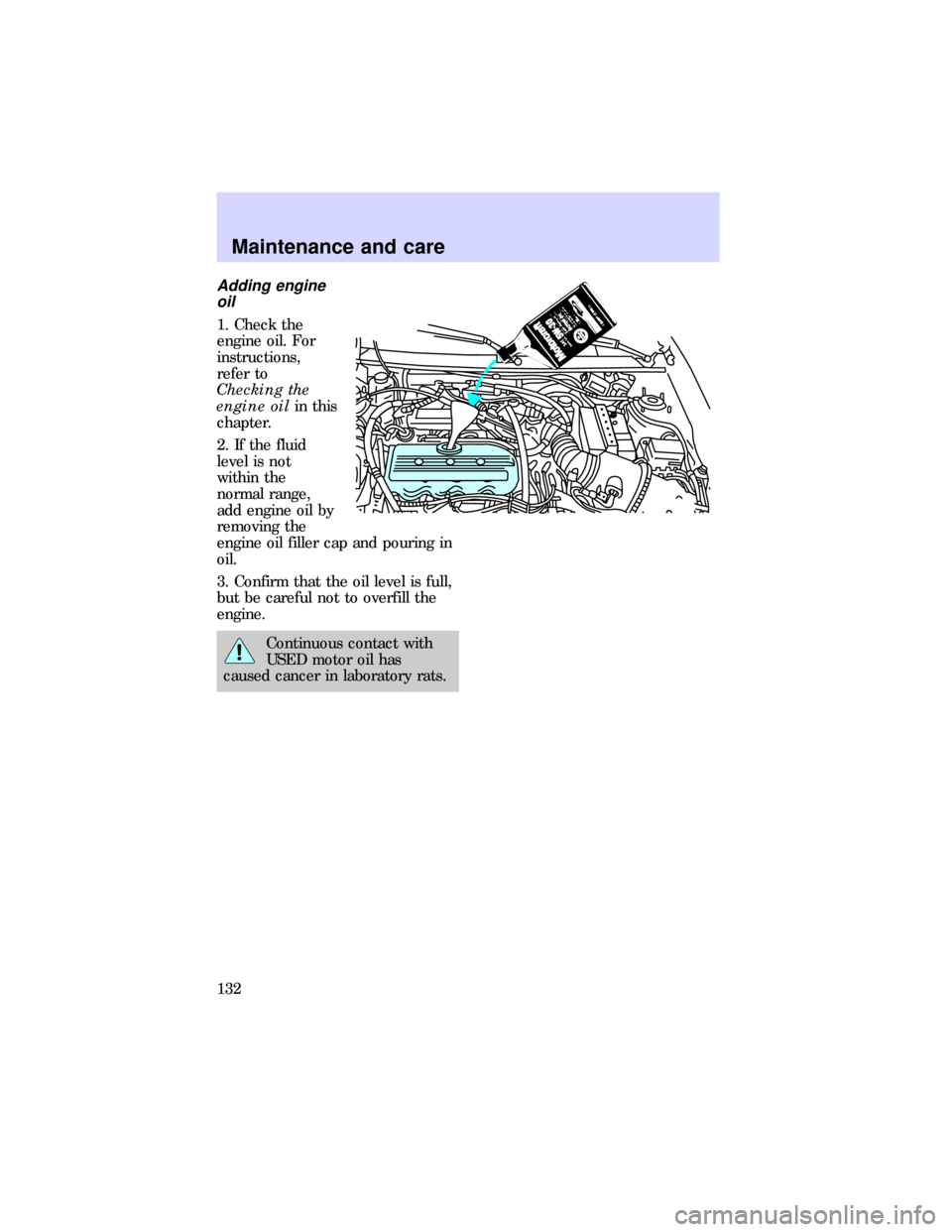
Adding engine
oil
1. Check the
engine oil. For
instructions,
refer to
Checking the
engine oilin this
chapter.
2. If the fluid
level is not
within the
normal range,
add engine oil by
removing the
engine oil filler cap and pouring in
oil.
3. Confirm that the oil level is full,
but be careful not to overfill the
engine.
Continuous contact with
USED motor oil has
caused cancer in laboratory rats.
Maintenance and care
132
Page 133 of 191
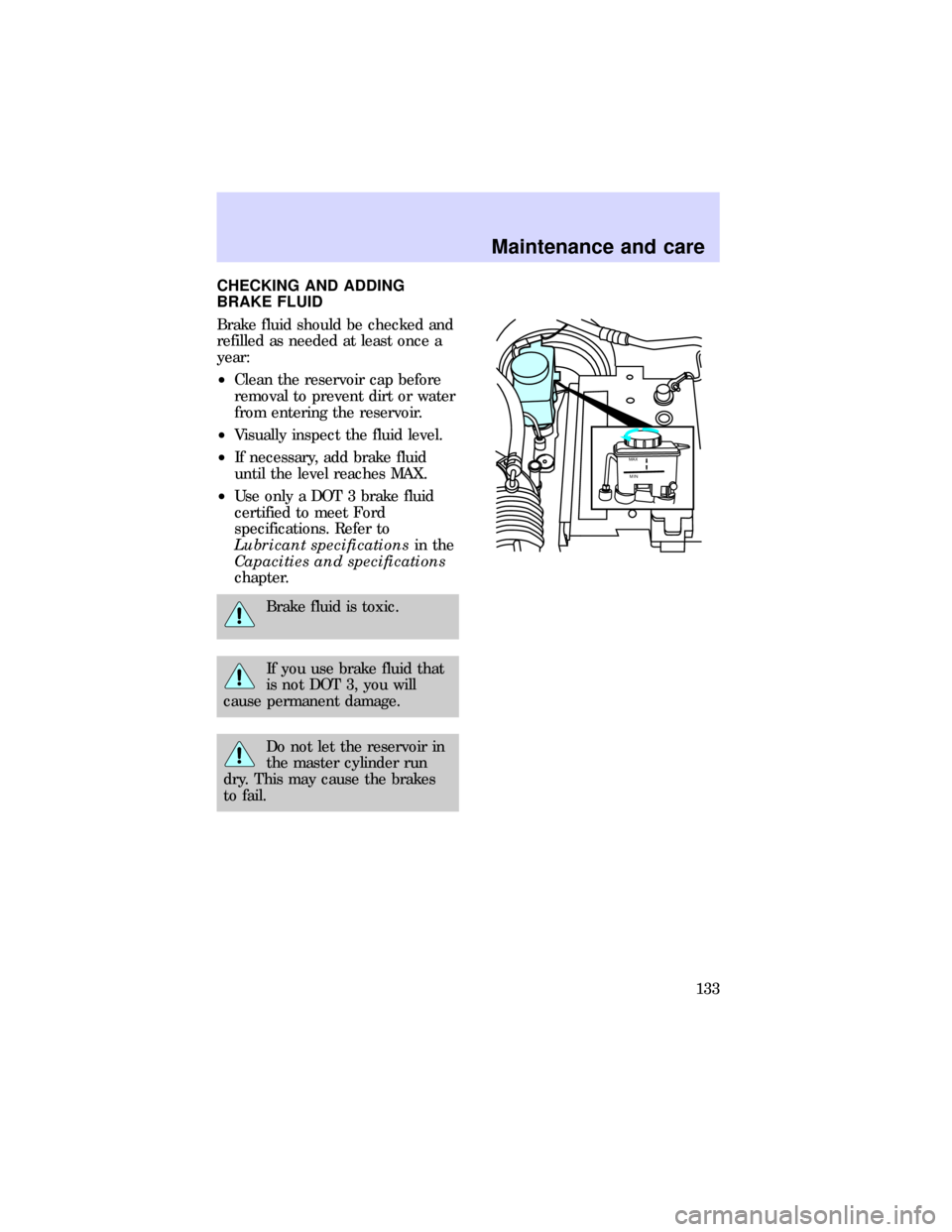
CHECKING AND ADDING
BRAKE FLUID
Brake fluid should be checked and
refilled as needed at least once a
year:
²Clean the reservoir cap before
removal to prevent dirt or water
from entering the reservoir.
²Visually inspect the fluid level.
²If necessary, add brake fluid
until the level reaches MAX.
²Use only a DOT 3 brake fluid
certified to meet Ford
specifications. Refer to
Lubricant specificationsin the
Capacities and specifications
chapter.
Brake fluid is toxic.
If you use brake fluid that
is not DOT 3, you will
cause permanent damage.
Do not let the reservoir in
the master cylinder run
dry. This may cause the brakes
to fail.
MAX
MIN
Maintenance and care
133
Page 134 of 191
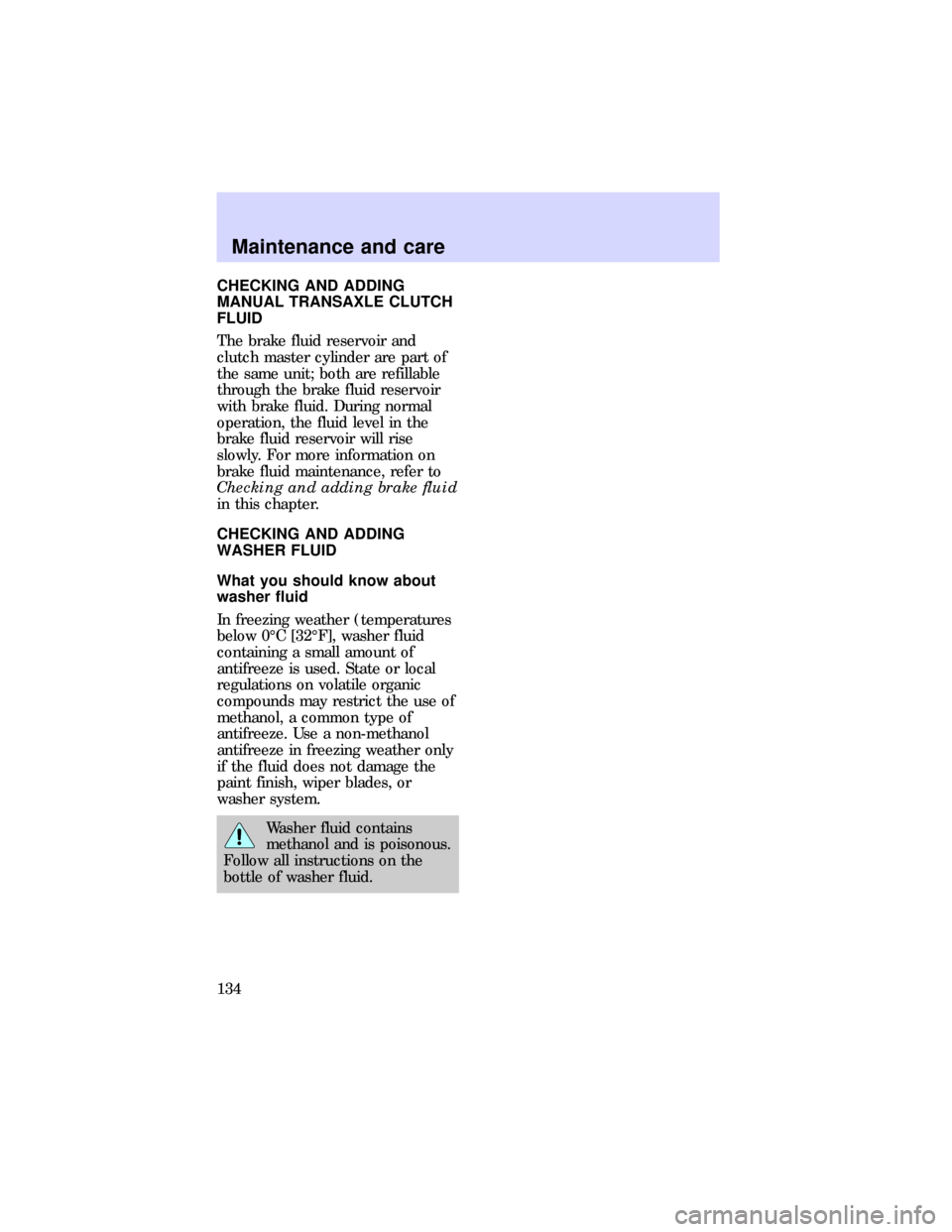
CHECKING AND ADDING
MANUAL TRANSAXLE CLUTCH
FLUID
The brake fluid reservoir and
clutch master cylinder are part of
the same unit; both are refillable
through the brake fluid reservoir
with brake fluid. During normal
operation, the fluid level in the
brake fluid reservoir will rise
slowly. For more information on
brake fluid maintenance, refer to
Checking and adding brake fluid
in this chapter.
CHECKING AND ADDING
WASHER FLUID
What you should know about
washer fluid
In freezing weather (temperatures
below 0ÉC [32ÉF], washer fluid
containing a small amount of
antifreeze is used. State or local
regulations on volatile organic
compounds may restrict the use of
methanol, a common type of
antifreeze. Use a non-methanol
antifreeze in freezing weather only
if the fluid does not damage the
paint finish, wiper blades, or
washer system.
Washer fluid contains
methanol and is poisonous.
Follow all instructions on the
bottle of washer fluid.
Maintenance and care
134
Page 135 of 191
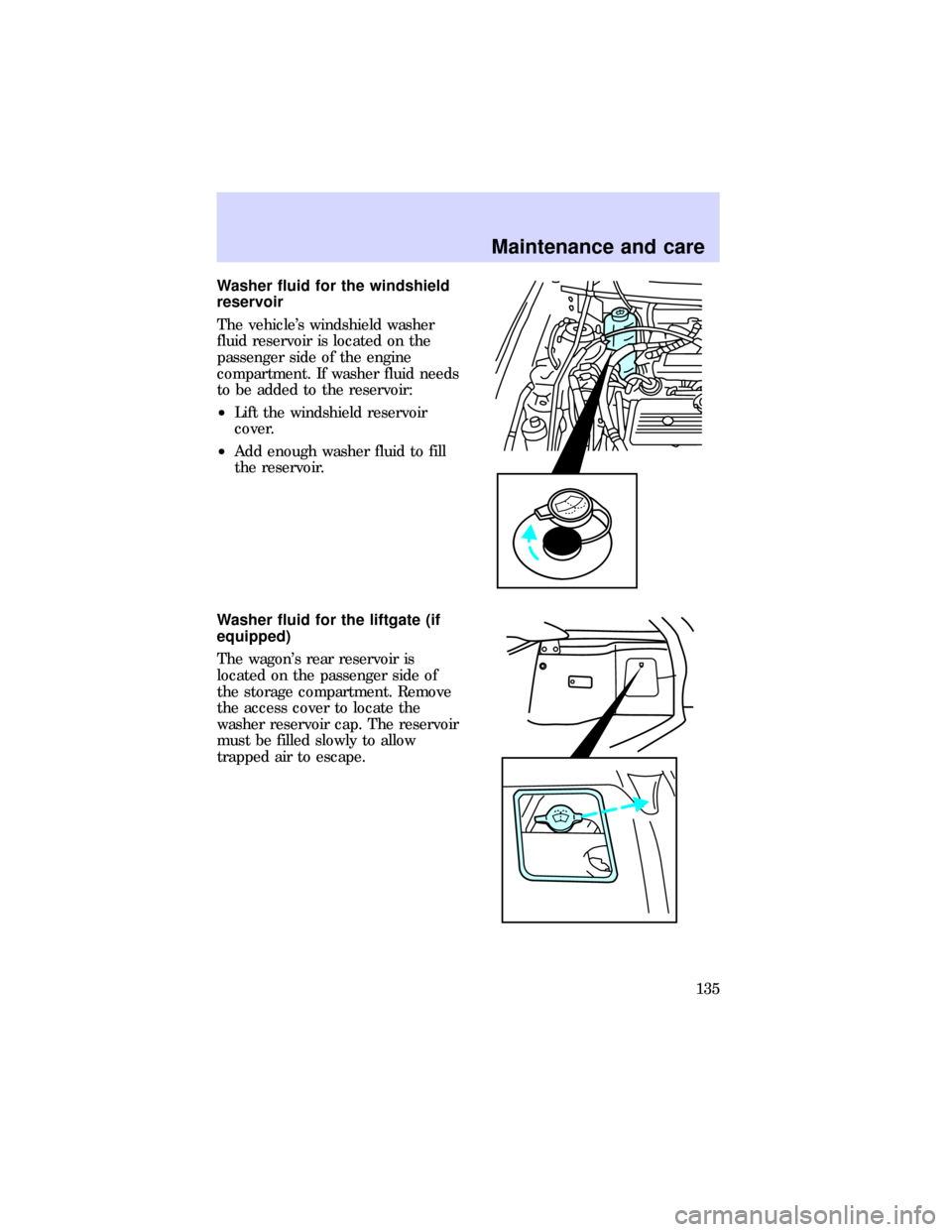
Washer fluid for the windshield
reservoir
The vehicle's windshield washer
fluid reservoir is located on the
passenger side of the engine
compartment. If washer fluid needs
to be added to the reservoir:
²Lift the windshield reservoir
cover.
²Add enough washer fluid to fill
the reservoir.
Washer fluid for the liftgate (if
equipped)
The wagon's rear reservoir is
located on the passenger side of
the storage compartment. Remove
the access cover to locate the
washer reservoir cap. The reservoir
must be filled slowly to allow
trapped air to escape.
Maintenance and care
135
Page 136 of 191
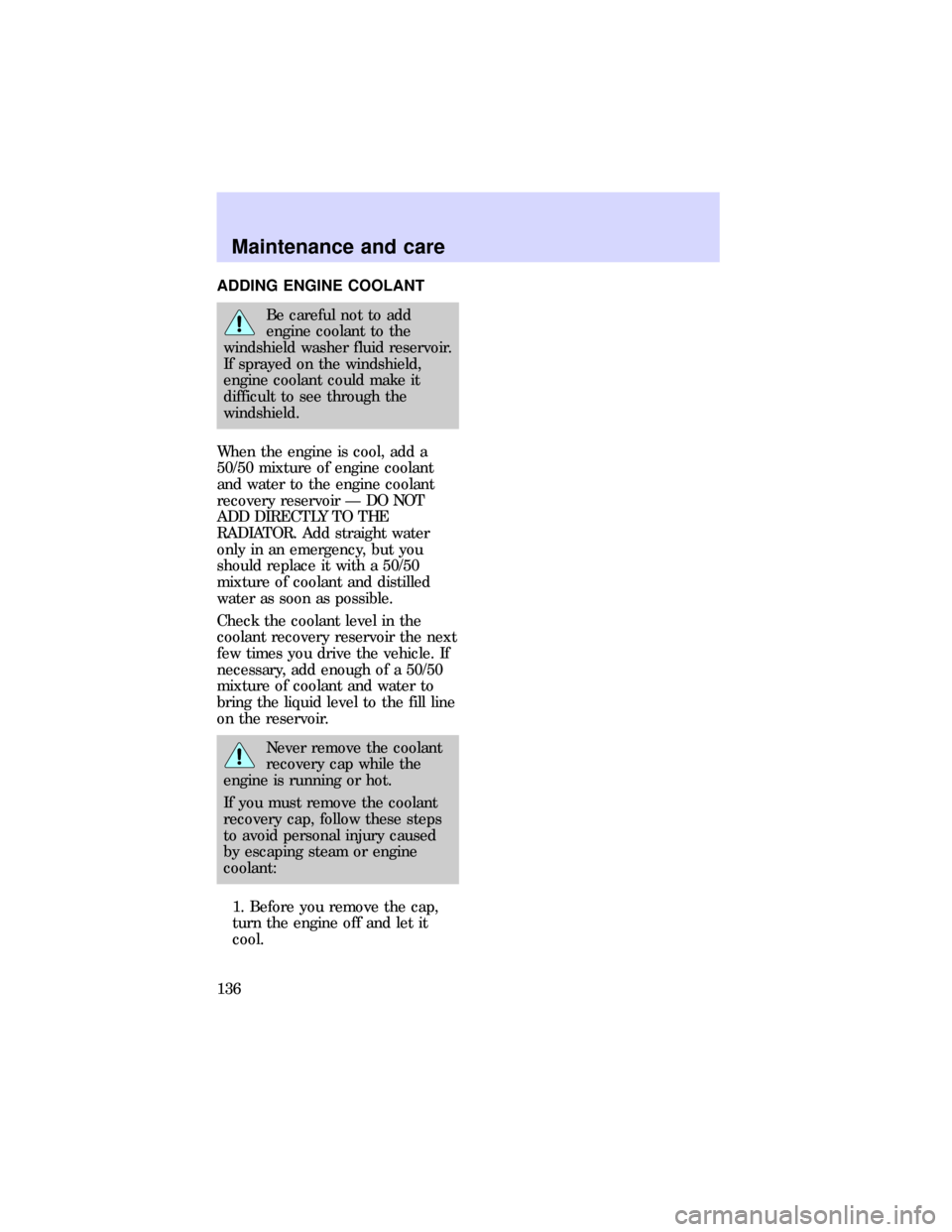
ADDING ENGINE COOLANT
Be careful not to add
engine coolant to the
windshield washer fluid reservoir.
If sprayed on the windshield,
engine coolant could make it
difficult to see through the
windshield.
When the engine is cool, add a
50/50 mixture of engine coolant
and water to the engine coolant
recovery reservoir Ð DO NOT
ADD DIRECTLY TO THE
RADIATOR. Add straight water
only in an emergency, but you
should replace it with a 50/50
mixture of coolant and distilled
water as soon as possible.
Check the coolant level in the
coolant recovery reservoir the next
few times you drive the vehicle. If
necessary, add enough of a 50/50
mixture of coolant and water to
bring the liquid level to the fill line
on the reservoir.
Never remove the coolant
recovery cap while the
engine is running or hot.
If you must remove the coolant
recovery cap, follow these steps
to avoid personal injury caused
by escaping steam or engine
coolant:
1. Before you remove the cap,
turn the engine off and let it
cool.
Maintenance and care
136
Page 137 of 191

2. When the engine is cool, wrap
a thick cloth around the cap and
turn it slowly, counterclockwise
to the first stop.
3. Step back while the pressure
releases.
4. When you are sure that all the
pressure has been released, use
the cloth to press the cap down,
turn it counterclockwise, and
remove it.
Use Ford Premium Engine Coolant
E2FZ-19549-AA (in Canada,
Motorcraft CXC-8-B) or an
equivalent premium engine coolant
that meets Ford Specification
ESE-M97B44-A. Ford Premium
Engine Coolant is an optimized
formula that will protect all metals
and rubber elastomers used in
Ford cooling systems for 4 years or
50,000 miles (80,000 km).
Do not use alcohol or methanol
antifreeze or any engine coolants
mixed with alcohol or methanol
antifreeze. Do not use
supplemental coolant additives in
your vehicle. These additives may
harm your engine cooling system.
The use of an improper coolant
may void the warranty of your
vehicle's engine cooling system.
Recycled Engine Coolant
Ford Motor Company recommends
that Ford and Lincoln-Mercury
dealers use recycled engine
coolant produced by
Ford-approved processes. Not all
coolant recycling processes
Maintenance and care
137
Page 138 of 191

produce coolant which meets Ford
specification ESE-M97B44-A, and
use of such coolant may harm
engine and cooling system
components.
Always dispose of used automotive
fluids in a responsible manner.
Follow your community's
regulations and standards for
recycling and disposing of
automotive fluids.
Coolant Refill Capacity
To find out how much fluid your
vehicle's cooling system can hold,
seeRefill capacities for fluidsin
the Index.
Have your dealer check the engine
cooling system for leaks if you
have to add more than a quart
(liter) of engine coolant per
month.
Severe Winter Climate
If you drive in extremely cold
climates (less than -34ÉF [-36ÉC]),
it may be necessary to increase the
coolant concentration above 50%.
Refer to the chart on the coolant
container to ensure the coolant
concentration in your vehicle is
such that the coolant will not
freeze at the temperature level in
which you drive during winter
months. Never increase the engine
coolant concentration above 60%.
Leave a 50/50 mixture of engine
coolant and water in your vehicle
year-round in non-extreme
climates.
Maintenance and care
138
Page 139 of 191
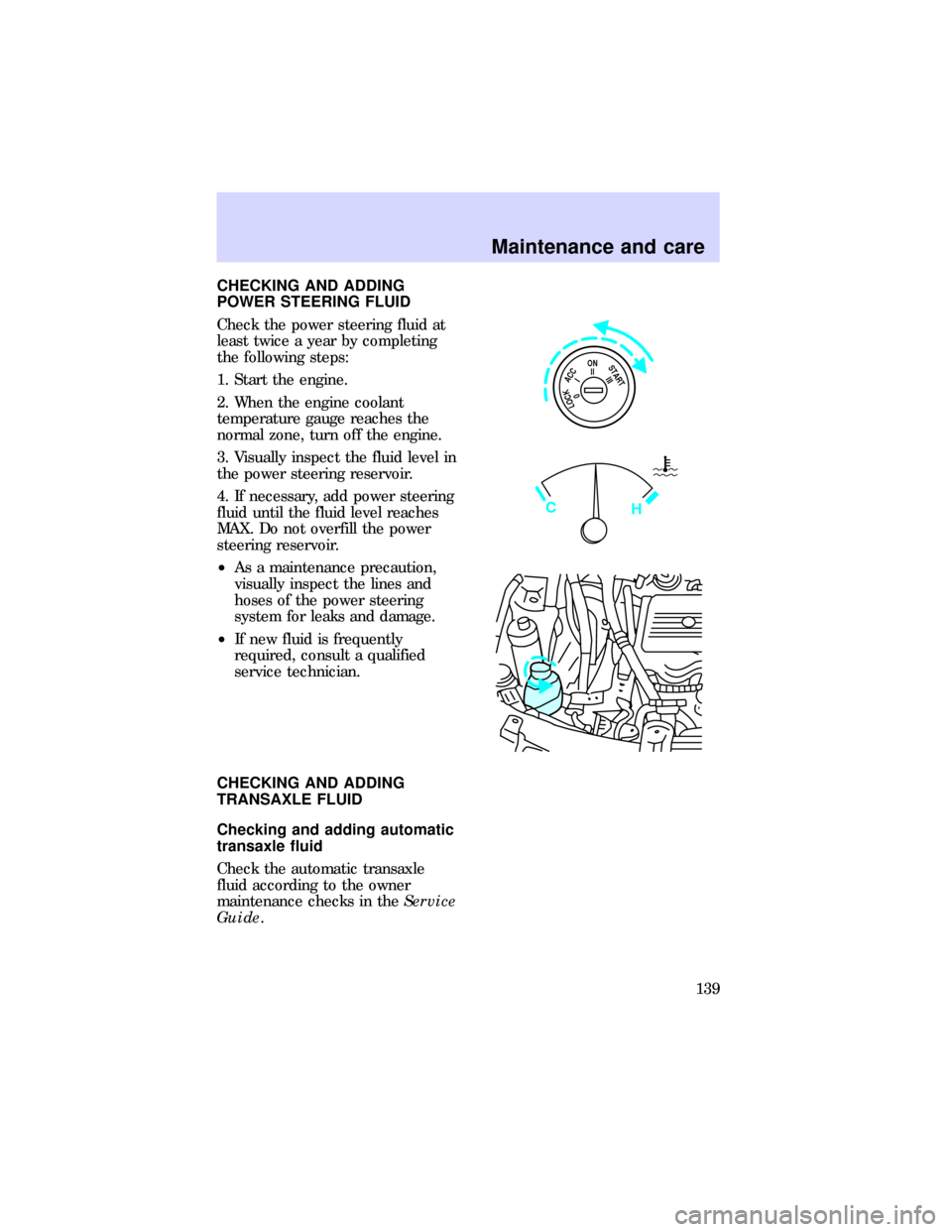
CHECKING AND ADDING
POWER STEERING FLUID
Check the power steering fluid at
least twice a year by completing
the following steps:
1. Start the engine.
2. When the engine coolant
temperature gauge reaches the
normal zone, turn off the engine.
3. Visually inspect the fluid level in
the power steering reservoir.
4. If necessary, add power steering
fluid until the fluid level reaches
MAX. Do not overfill the power
steering reservoir.
²As a maintenance precaution,
visually inspect the lines and
hoses of the power steering
system for leaks and damage.
²If new fluid is frequently
required, consult a qualified
service technician.
CHECKING AND ADDING
TRANSAXLE FLUID
Checking and adding automatic
transaxle fluid
Check the automatic transaxle
fluid according to the owner
maintenance checks in theService
Guide.
ON
II
ACC
I
LOCK
0
START
III
C
H
Maintenance and care
139
Page 140 of 191
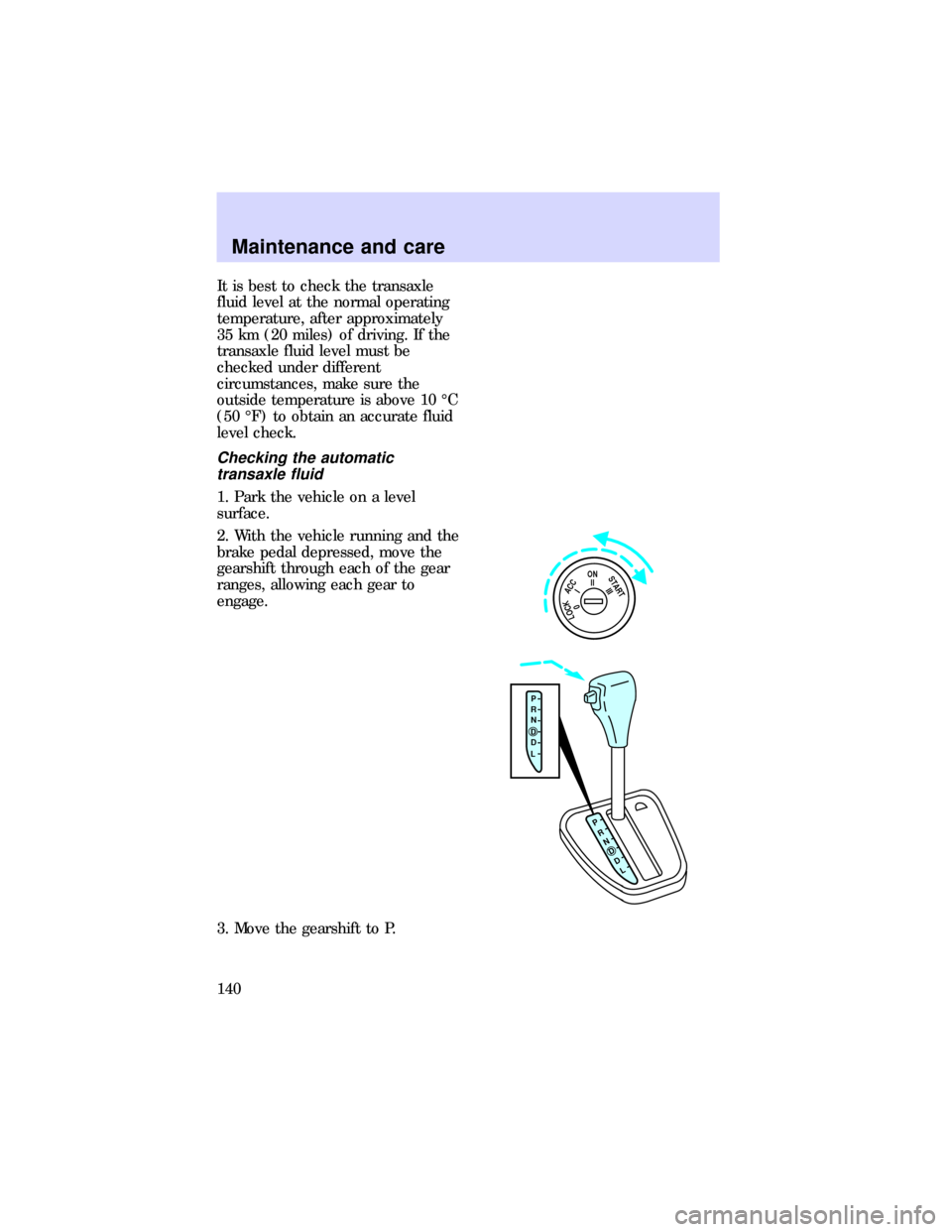
It is best to check the transaxle
fluid level at the normal operating
temperature, after approximately
35 km (20 miles) of driving. If the
transaxle fluid level must be
checked under different
circumstances, make sure the
outside temperature is above 10 ÉC
(50 ÉF) to obtain an accurate fluid
level check.
Checking the automatic
transaxle fluid
1. Park the vehicle on a level
surface.
2. With the vehicle running and the
brake pedal depressed, move the
gearshift through each of the gear
ranges, allowing each gear to
engage.
3. Move the gearshift to P.
P
R
N
D
D
L
R
N
D
D
LP
ON
II
ACC
I
LOCK
0
START
III
Maintenance and care
140